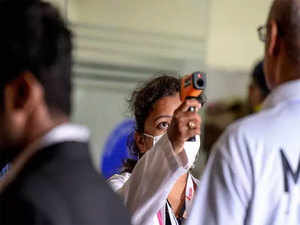 Agencies
AgenciesCovid-19 cases have well entered the triple-digit territory in India. Our approach has grown from scrutinising airport arrivals and evacuating citizens from affected areas to sizeable shutdowns of public space and mass activities. So far, we haven’t witnessed the kind of viral rampage that Italy or Iran is experiencing.
But experts have warned about deficient testing of suspects, thus advising greater deployment of testing machinery along the lines of South Korea.
For India, still in the initial stages of the scourge, it is not much of a question as to whether community spread will happen or not, but rather, to what extent.
There is little room for laxity when it comes to measures like social distancing. However, sooner or later, Covid-19 could dare India’s frail capacity to handle severe cases.
In Italy, where cases spiralled from tens to tens of thousands in less than three weeks, surging influx of patients has already begun overwhelming hospital capacity. This has resulted in guidelines calling for rationing beds and ventilators, prioritising those with better chances of survival.
In the US, it has been estimated that a moderate outbreak will result in more than six critically ill patient competing for every hospital bed (assuming all beds are empty). Even in Wuhan, China, doctors had to take hard decisions related to rationing beds and ventilators.
Italy, US and China have 3.2, 2.8 and 4.3 hospital beds per 1,000 people respectively.
Clearly, with a bed-population ratio of nearly 1:1,000, and with around one million hospital beds and less than
100,000 intensive care unit (ICU) beds, India is hardly prepared to confront amoderate surge. This is compounded by two sets of challenges.
The first includes the typical aspects of the disease itself — its propensity to produce severe illness in those with comorbid conditions, thus complicating the management; the protracted course of illness, with 3-6 weeks to recovery and up to 21 days of ventilator support needed for critical cases; and its infectious nature precluding use
of general ward beds for admission.
Healing Touch for Hospitals
The second set encompasses weak public sector hospital capacity, which further suffers from stark maldistribution between, and within, regions and states. Nearly three-fourths of private corporate hospitals are located in less than 40 districts, and over four-fifths of hospitals have less than 30 beds. Standards for isolation and infection control remain dubious in such small establishments.
Inadequacies pertaining to manpower and supplies follow similar lines. While roping in the private sector for widespread Covid-19 testing has been suggested, it could to be particularly challenging to get the private sector on board for widespread management of severe cases.
Without doubt, an under-preparedness in dealing with a possible surge in Covid-19 cases needing hospital care can have nightmarish consequences.
It becomes imperative to grow wary of a potential situation in which patients are needed to be unfeelingly triaged — prioritised in order of treatment required — particularly given the murky standards and ethics followed in rationing medical care in India.
The crisis also affords an opportunity to reflect on the policy failures behind India’s weak public sector hospital capacity. While a disproportionate share of public health spending going into urban-based curative care vis-à-vis primary care has been criticised over decades, the public hospital sector has not received even a fraction of its due. Since the 1980s, policy deliberations have sought to shift the larger responsibility of inpatient care provisioning to the private sector, often under the pretext of focusing on primary care.
The Pradhan Mantri Swasthya Suraksha Yojana (PMSSY), a scheme announced in 2003 to strengthen tertiary care, was closely followed by the National Rural Health Mission (NRHM) in 2005, a primary care programme.
While NRHM has arguably been successful in many respects, PMSSY has been sluggish and afflicted with poor planning. Establishment of new All India Institutes of Medical Sciences (Aiims) and upgradation of medical colleges under the scheme have recorded time-overruns of the order of 4-6 years, not to mention glaring shortages of faculty, non-functional departments, and idle or uninstalled medical equipment.
There is an urgent need of ramping up control measures to avert a possible ugly onslaught of Covid-19 on the health system. A middle path between China’s lockdown and South Korea’s mass-testing approaches can be considered. However, the need for advance planning and preparedness to buttress our institutional capacity to deal with excesses mustn’t be overlooked.
This would involve effective mobilisation of a wide range of stakeholders, including the private sector. Makeshift arrangements for hospital beds, health manpower, and sourcing in supplies would need to be planned for tackling a possible future deluge of severe and critical Covid-19 cases. The role of innovative indigenous solutions to fill gaps would also be crucial.
Proactivity as Insurance
For the long run, however, the pandemic serves as an eye-opener in delivering two important messages. One, health systems cannot pursue an exclusionary approach to universal healthcare by neglecting hospital care.
The acute encephalitis syndrome (AES) outbreak in Bihar in 2019 locally overwhelmed hospital systems. The consequences can be much more baleful with a highly contagious disease agent.
Two, the State cannot afford to transfer responsibility improvidently to the private health sector. These times are a testimony to how a massive insurance scheme can be no answer to a problem like Covid-19, which respects no eligibility barriers.
The writer, a Mumbai-based doctor, is editor, The Indian Practitioner
Download The Economic Times News App to get Daily Market Updates & Live Business News.
Subscribe to The Economic Times Prime and read the ET ePaper online.
Read More News on
Download The Economic Times News App to get Daily Market Updates & Live Business News.
Subscribe to The Economic Times Prime and read the ET ePaper online.









 Get Unlimited Access to The Economic Times
Get Unlimited Access to The Economic Times
